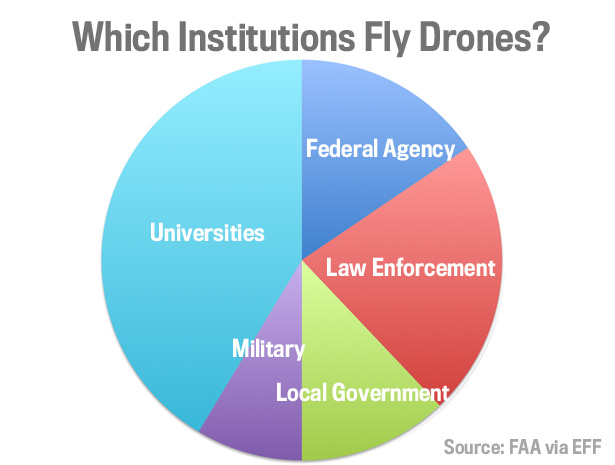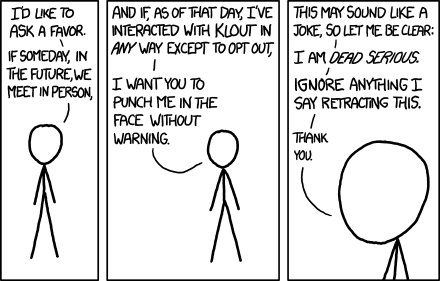An iconographic and text archive related to communication, technology and art.
This past week link roundup includes an introduction to the “urban datasexual” (a new mode of subjectivation?), a chart showing who’s authorized to fly drones in the United-States, a new gallery of images related to New York’s history, spambots which started to do philosophy (self-awarness will likely be reached in a near future: according to XKCD, there’s nothing to worry about), the increasing popularity of self-tracking, a couple of interesting resources about Klout (online influence tracking), some thoughts about “the cloud”, and more.
• • •
- The New Republic: “How ‘The Godfather’ Was Diminished By Its State-of-the-Art Restoration” by David Thomson, April 24, 2012. Excerpt:
The Godfather was, for a moment, the most successful film ever at the box office. And now it is not exactly a film, but something fit for plush seating and Doremi servers. No, I haven’t seen this version, but I have seen enough digital projection in “complete entertainment environments” to be wary of the technical coldness of the show, and an end to that feeling of light falling on skin—photography, where appearance has burned into silver salts.
- Big Think: “Meet the Urban Datasexual” by Dominic Basulto, April 16, 2012. Excerpt:
The origin of the datasexual in all likelihood started with the humble infographic, which is a highly stylized and well-designed way to talk about all the data out there on Web. The infographic trend was followed by the data visualization trend, which made it even cooler to display data in innovative new ways. These data visualization tools eventually gave us cultural artifacts like Nicholas Felton’s annual Feltron Reports, which made the obsessive recording of everyday activities seem cool. From there, it was only a small evolutionary step to the whole quantified self (QS) movement, which promises “self knowledge through numbers.” QS proponents obsessively track every single bit of data about themselves throughout the day. The QS movement eventually led us to the embrace of data by consumer-facing companies Nike, who found a way for urban datasexuals to flaunt their obsessive data-grooming to the rest of us in a way that’s stylish and mod.
- Journal of Historians of Netherlandish Art: “Dirty Books: Quantifying Patterns of Use in Medieval Manuscripts Using a Densitometer” by Kathryn M. Rudy, vol. 2, issue 1-2, 2010 (PDF). Abstract:
Early users of medieval books of hours and prayer books left signs of their reading in the form of fingerprints in the margins. The darkness of their fingerprints correlates to the intensity of their use and handling. A densitometer — a machine that measures the darkness of a reflecting surface — can reveal which texts a reader favored
- The Atlantic: “Who Has the Right to Fly a Drone Above Your Head? Finally, There’s a List” by Alexis Madrigal, April 25, 2012.
- NYC Department of Records: “The NYC Department of Records announces on-line access to a gallery of over 870,000 images”. Direct access to the gallery here. Depending on your location, servers may be down “due to overwhelming demand”.
- Associated Press (via Fox News): “Breivik’s publicity at trial just what he wanted”, April 25, 2012. Excerpt:
As Anders Behring Breivik has given shocking and remorseless accounts to a Norwegian court of how he massacred 77 people, his testimony has revived a debate about how much of a public platform mass-murderers should be given in trials.
- Ian Bogost: “My spam readers…might be more interesting than my human ones” April 21, 2012. Excerpt:
(…) this morning I found a new salvo of incredibly persuasive imitations in my blog comments. There’s no doubt that they are spam, but its now clear that the spambots are carefully reading my blog (and other, related blogs)—perhaps more carefully than many human readers.
- Rhizome: “A Conversation with Jonathan Lethem” by Joanne McNeil, April 26, 2012. Excerpt:
I’ve always been a very late adopter. I mean even MP3s, I didn’t have them after other people I knew did. Something about me always sort of wants them to become a little more part of the world. It’s like I need to believe in them by seeing people form attachments before I make that move. I’ve got a friend who teases me because he remembers me saying that I would probably never bother with email. I knew a few people who were doing it and it just didn’t seem that appealing to me. Now I’m ten years into an unbelievable promiscuous emailing binge that will never end. So I’ve been a late adopter a lot of times with tech.
- Quantified Self: Self knowledge trough numbers.
Quantified Self is a collaboration of users and tool makers who share an interest in self knowledge through self-tracking. We exchange information about our personal projects, the tools we use, tips we’ve gleaned, lessons we’ve learned. We blog, meet face to face, and collaborate online. (About)
- Klout:
Our friendships and professional connections have moved online, making influence measurable for the first time in history. When you recommend, share, and create content you impact others. Your Klout Score measures that influence on a scale of 1 to 100.
- The New Yorker: “Klout is evil, but it can be saved” by Nicholas Thompson, April 27, 2012.
Klout grades users on a scale of one to a hundred based on some proprietary algorithm that counts how often your comments are retweeted, liked, or shared. If you want your score to go up, tweet more and get influential people to retweet you. Don’t ever go on vacation. If you’re on a social network, Klout gets your score, whether you’ve ever logged into the service or not. Think of a mercenary socialite, holding a calculator and trying to figure out who to invite to a party based on import. Then put whatever number she arrives at on every guest’s lapel. That’s Klout.
See also Klouchbag by Tom Scott (Flash is required, as well as a good sense of humor). [UPDATE–May 18, 2012] See also Randall Munroe’s take on Klout (from his XKCD web comic no. 1057):
- Wired: “What Your Klout Score Really Means” by Seth Stevenson, April 24, 2012. Excerpt:
The interviewer pulled up the web page for Klout.com—a service that purports to measure users’ online influence on a scale from 1 to 100—and angled the monitor so that Fiorella could see the humbling result for himself: His score was 34. “He cut the interview short pretty soon after that,” Fiorella says. Later he learned that he’d been eliminated as a candidate specifically because his Klout score was too low. “They hired a guy whose score was 67.”
- The Poetry Foundation: “Why I Don’t Trust the Cloud” by Kenneth Goldsmith, April 27, 2012. K. Goldsmith is the founding editor of UbuWeb. Excerpt:
Don’t trust the cloud. Use it, enjoy it, exploit it, but don’t believe in it. Or even the web for that matter. Many people assume that the web —and its riches—will always be there waiting for you. It won’t. Don’t bookmark. Download. Hard drives are cheap. Fill them up with everything you think you might need to consult, watch, read, listen to, or cite in the future.
- By Philippe Theophanidis
- on
- ― Published in Link-roundup








